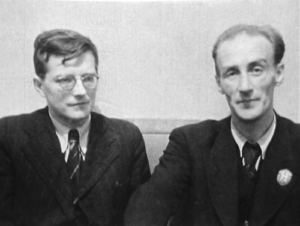On September 21, 22 & 23, the Houston Symphony performs Shostakovich’s Symphony No. 9 as part of its Bronfman Plays Prokofiev program led by Music Director Andrés Orozco-Estrada. Learn more about this fascinating work in the post below.

Like Prokofiev’s First Symphony, Shostakovich’s Ninth was written in a fateful year: 1945. It also subverted the expectations of the Russian musical world, much as Prokofiev’s symphony had done decades earlier. Shostakovich composed the work during the summer at Ivanovo, a rural composer’s retreat several hours northeast of Moscow. Daniil Zhitomirsky, a sympathetic critic who was also at Ivanovo that summer, recalled, “After the Seventh and Eighth, everyone was awaiting the triumphal Victory Symphony.” Indeed, the double significance of the U.S.S.R.’s victory in World War II and the numerical symbolism of a Ninth Symphony (which invited comparisons with Beethoven’s utopian Ninth Symphony) put pressure on Shostakovich to compose a grandiose piece that would glorify Stalin’s regime.
Having been terrorized by that regime, Shostakovich was not particularly willing to comply; open defiance, however, was impossible, and in the months leading up to the summer Shostakovich led everyone on with promises of a symphony that would use “not only the orchestra, but also a chorus as well as soloists.” The symphony he actually wrote could not have been more different. This was a tactic Shostakovich would use time and time again—promising to compose the piece the regime wanted while actually giving it something else.
Shostakovich’s Ninth is totally devoid of pompous grandeur; in its place is a compact, transparent, classically-oriented work not unlike Prokofiev’s First Symphony. But in place of the sincere, uncomplicated joy Prokofiev sought to evoke is a much more complex emotional landscape. The great conductor Yevgeny Mravinsky, who would give the premiere of the symphony, wrote that it “scoffs at complacency, pompousness, the ‘desire to rest on one’s laurels’, and sing one’s own praises,” but also noted that “the symphony is not entirely ironical. It also has genuine lyricism and profound sorrow.” Paramount is Shostakovich’s sense of humor: irreverent, absurdist and sardonic.
The Music
The first movement begins with a chipper theme in the violins that instantly dispelled any expectation of monumentality that the audience might have had at the premiere:
The entrance of the snare drum and a trombone (which obnoxiously repeats the same two notes over and over) announces the march-like second theme. Mravinsky commented that “the light-hearted, frivolous ‘jesting’” of this theme in particular expressed not “the feelings of the composer himself, but of his antipode, a self-satisfied, narrow-minded and, essentially, utterly indifferent Philistine.”
In total conformity with the practices of Mozart’s day, Shostakovich ironically includes a repeat of the two main themes before going on to the development, during which the “Philistine” second theme returns in a belligerent guise. The main themes are then reprised, although the unsettling developmental music continues to permeate the movement up until its sudden, rather perfunctory ending.

The second movement begins with a long, twilight clarinet solo. Gradually, more woodwinds join the melody. Just as it seems about to die away, the strings enter with an uncanny, swaying figure. The music becomes more intense, building to a climax and fading away to the return of the opening melody, this time as a flute solo. The swaying string figure also returns, this time leading to a quiet coda featuring a final reminiscence of the opening theme in the piccolo.
The third movement begins with a fast, cheerful theme for clarinet. As more instruments enter and the theme develops, it becomes increasingly maniacal, spinning out of control. At the theme’s conclusion, the strings begin an intense accompaniment figure, above which a theatrical trumpet solo appears, full of bravado. The opening theme then reappears, but this time it seems to unravel as it progresses. The music becomes softer and slower, fading seamlessly into the next movement.
The fourth movement is the slow, soulful heart of the symphony; here is the “genuine lyricism and profound sorrow” Mravinsky found. It begins with a solemn, stern idea in the trombones and tuba that alternates with expressive, quasi-improvisatory bassoon solos. In a wicked twist, the bassoon’s final note slips into what Mravinsky called “the somehow affected, unjustified merriment of the finale.” The bassoon introduces the clownish main theme of the movement, which alternates with contrasting episodes; beneath the show of jollity is a deep-seated unease that erupts at the movement’s climax. The finale ends with a bitingly satirical version of the main theme as a vaudeville-like presto.
Surprisingly, the symphony was initially well-received by Soviet critics. It was not until Zhdanov issued his infamously repressive decree the following year that it was condemned. One critic by the name of Koval wrote, “What was Shostakovich counting on when, instead of creating in the Ninth Symphony the image of the victorious man, he created one of a carefree Yankee recklessly whistling a cheerful little tune?” Shostakovich managed to weather this storm, but he would not compose another symphony until Stalin was safely dead. —Calvin Dotsey
Don’t miss Shostakovich’s Symphony No. 9 on September 21, 22 & 23! Get tickets and more information at houstonsymphony.org.



